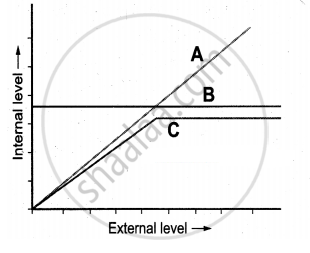Advertisements
Chapters
2: Human Reproduction
3: Reproductive Health
4: Principles of Inheritance and Variation
5: Molecular Genetics
6: Evolution
7: Human Health and Diseases
8: Microbes in Human Welfare
9: Applications of Biotechnology
▶ 10: Organisms and Populations
11: Biodiversity and its Conservation
12: Environmental Issues
![Samacheer Kalvi solutions for Biology (Zoology) [English] Class 12 TN Board chapter 10 - Organisms and Populations Samacheer Kalvi solutions for Biology (Zoology) [English] Class 12 TN Board chapter 10 - Organisms and Populations - Shaalaa.com](/images/biology-zoology-english-class-12-tn-board_6:5f2b1b2038084cf381bfa42c826a928c.jpg)
Advertisements
Solutions for Chapter 10: Organisms and Populations
Below listed, you can find solutions for Chapter 10 of Tamil Nadu Board of Secondary Education Samacheer Kalvi for Biology (Zoology) [English] Class 12 TN Board.
Samacheer Kalvi solutions for Biology (Zoology) [English] Class 12 TN Board 10 Organisms and Populations Evaluation [Pages 178 - 179]
All populations in a given physical area are defined as ________.
Biome
Ecosystem
Territory
Biotic factors
Organisms which can survive a wide range of temperatuer are called _________.
Ectotherms
Eurytherms
Endotherms
Stenotherms
The interaction in nature, where one gets to benefit on the expense of other is _________.
Predation
Mutualism
Amensalism
Commensalism
Predation and parasitism are which type of interactions?
(+,+)
(+, O)
(−, −)
(+, −)
Competition between species leads to ________.
Extinction
Mutation
Amensalism
Symbiosis
Which of the following is an r-species
Human
Insects
Rhinoceros
Whale
Match the following and choose the correct combination from the options given below.
| Column I | Column II |
| Mutualism | Lion and deer |
| Commensalism | Round worm and man |
| Parasitism | Birds compete with squirrels for nuts |
| Competition | Sea anemone on hermit crab |
| Predation | Barnacles attached to Whales |
A - 4, B - 5, C - 2, D - 3, E - 1
A - 3, B - 1, C - 4, D - 2, E - 5
A - 2, B - 3, C - 1, D - 5, E - 4
A - 5, B - 4, C - 2, D - 3, E - 1
The figure given below is a diagrammatic representation of response of organisms to abiotic factors. What do A, B and C represent respectively.

| S. No. | A | B | C |
| a. | Conformer | Regulator | Partial Regulator |
| b. | Regulator | Partial Regulator | Conformer |
| c. | Partial Regulator | Regulator | Conformer |
| d. | Regulator | Conformer | Partial Regulator |
The relationship between sucker fish and shark is _________.
Competition
Commensalism
Predation
Parasitism
Which of the following is correct for r-selected species
Large number of progeny with small size
Large number of progeny with large size
Small number of progeny with small size
Small number of progeny with large size
Animals that can move from fresh water to sea called as ________.
Stenothermal
Eurythermal
Catadromous
Anadromous
Some organisms are able to maintain homeostasis by physical means ________.
Conform
Regulate
Migrate
Suspend
What is a Habitat?
Define ecological niche.
What is Acclimatisation?
What is Pedogenesis?
What is soil permeability?
Differentiate between Eurytherms and Stenotherms.
Explain hibernation and aestivation with examples.
Give the diagnostic characters features of a Biome?
Classify the aquatic biomes of Earth.
What are the ways by which organisms respond to abiotic factors?
Classify the adaptive traits found in organisms.
Distinguish between Natality and Mortality.
Differentiate J and S shaped curve
Give an account of population regulation.
Give an account of the properties of soil.
Differentiate between Tundra and Taiga Biomes.
List the adaptations seen in terrestrial animals.
Describe Population Age Distribution.
Describe Growth Models/Curves.
Tabulate and analysis of two species population interaction.
Explain parasitism.
Differentiate between predator and prey.
Solutions for 10: Organisms and Populations
![Samacheer Kalvi solutions for Biology (Zoology) [English] Class 12 TN Board chapter 10 - Organisms and Populations Samacheer Kalvi solutions for Biology (Zoology) [English] Class 12 TN Board chapter 10 - Organisms and Populations - Shaalaa.com](/images/biology-zoology-english-class-12-tn-board_6:5f2b1b2038084cf381bfa42c826a928c.jpg)
Samacheer Kalvi solutions for Biology (Zoology) [English] Class 12 TN Board chapter 10 - Organisms and Populations
Shaalaa.com has the Tamil Nadu Board of Secondary Education Mathematics Biology (Zoology) [English] Class 12 TN Board Tamil Nadu Board of Secondary Education solutions in a manner that help students grasp basic concepts better and faster. The detailed, step-by-step solutions will help you understand the concepts better and clarify any confusion. Samacheer Kalvi solutions for Mathematics Biology (Zoology) [English] Class 12 TN Board Tamil Nadu Board of Secondary Education 10 (Organisms and Populations) include all questions with answers and detailed explanations. This will clear students' doubts about questions and improve their application skills while preparing for board exams.
Further, we at Shaalaa.com provide such solutions so students can prepare for written exams. Samacheer Kalvi textbook solutions can be a core help for self-study and provide excellent self-help guidance for students.
Concepts covered in Biology (Zoology) [English] Class 12 TN Board chapter 10 Organisms and Populations are Organism and Its Environment, Habitat, Major Abiotic Components or Factors, Concept of Biome and Their Distribution, Responses to Abiotic Factors, Adaptations and Its Types, Population Attributes, Population Age Distribution, Growth Models / Curves, Population, Population Interactions.
Using Samacheer Kalvi Biology (Zoology) [English] Class 12 TN Board solutions Organisms and Populations exercise by students is an easy way to prepare for the exams, as they involve solutions arranged chapter-wise and also page-wise. The questions involved in Samacheer Kalvi Solutions are essential questions that can be asked in the final exam. Maximum Tamil Nadu Board of Secondary Education Biology (Zoology) [English] Class 12 TN Board students prefer Samacheer Kalvi Textbook Solutions to score more in exams.
Get the free view of Chapter 10, Organisms and Populations Biology (Zoology) [English] Class 12 TN Board additional questions for Mathematics Biology (Zoology) [English] Class 12 TN Board Tamil Nadu Board of Secondary Education, and you can use Shaalaa.com to keep it handy for your exam preparation.
